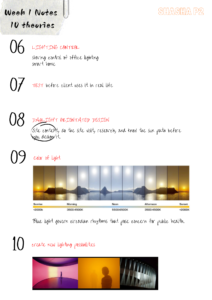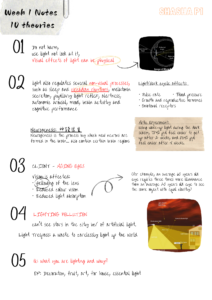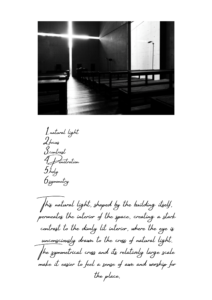Week 1 Notes & Class Exercise
Hello, This is my week 1 notes, class exercise, and my reflection based on week 1.
This is my Week 1 Notes 10 theories in pdf format, I also make it as 2 enlarged jpg here.


In week 1, I think that caring about the clients (users) when designing light for them is important, especially when your clients are older people.
From the class notes and my research, I realize:
As people age, their eyes undergo various changes that can affect how they see color and different types of light. These changes can affect how aging individuals perceive colors and different types of light. For example, older adults may have difficulty distinguishing between shades of blue and green. They may also have difficulty seeing the difference between colors that have a similar tone or saturation.
In addition to color perception, aging can also affect how people see different types of light. Older adults may experience a decreased ability to adjust to changes in light levels, which can make it harder for them to see in dimly lit environments. They may also be more sensitive to glare from bright lights, which can cause discomfort and make it harder to see.
I listed four lighting that might be harmful to my elder client:
- Low light levels: As people age, their eyes require more light to see clearly. Therefore, lighting that is too dim or low may not be suitable for older individuals, as it can make it harder for them to see and increase the risk of falls or accidents.
- Flickering lights: Flickering or flashing lights can be problematic for older adults, as they may trigger headaches, migraines, or seizures. Moreover, flickering lights can also cause visual discomfort and make it harder for older adults to concentrate or read.
- Glare: Bright lights or glare can be a significant problem for older adults. It can cause discomfort and reduce visual clarity, making it harder for them to see and increasing the risk of falls or accidents.
- Blue light: Some studies suggest that exposure to blue light may disrupt the sleep-wake cycle and affect circadian rhythms, particularly in older adults. Therefore, lighting that emits blue light may not be suitable for older individuals, especially in the evening or at night.
My lighting solution for my elder client:
It is best to choose lighting that is bright but not too harsh, with minimal glare and flicker. Lighting that is warm and diffused can be helpful, as it can reduce glare and provide a more comfortable and inviting atmosphere. Additionally, lighting that is adjustable or dimmable can be useful for older adults, as it allows them to customize the lighting to their needs and preferences.
This is my week 1 class exercise about choosing an image and describing the light.

Thank you for watching my week 1 blog!




Recent comments